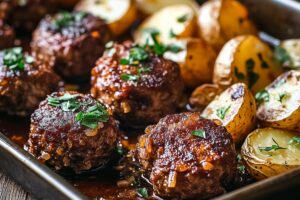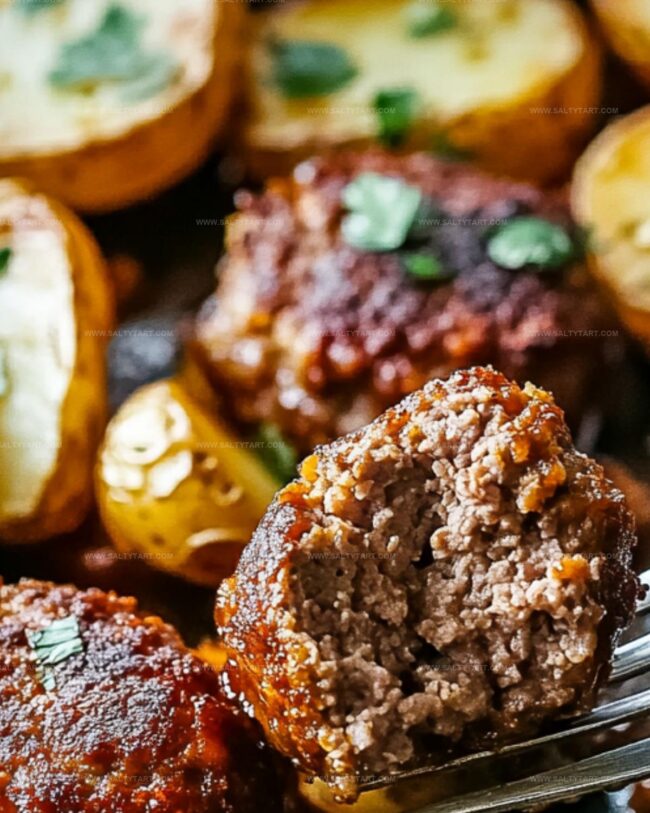Quick & Juicy Sheet Pan Mini Meatloaf And Roasted Potatoes Recipe
Comfort food reaches new heights with this sheet pan mini meatloaf and roasted potatoes recipe that promises a delightful dinner solution.
Weeknight meals can be both delicious and effortless with this one-pan wonder.
Each perfectly portioned mini meatloaf delivers robust flavor and tender texture.
Crispy potato edges complement the juicy meat, creating a balanced and satisfying plate.
The simple preparation means less time in the kitchen and more time enjoying a hearty meal.
Seasoned with classic herbs and spices, these mini meatloaves bring warmth and nostalgia to your dining table.
You’ll love how quickly this meal comes together with minimal cleanup.
Prepare to savor every bite of this comforting, no-fuss dinner that will have everyone asking for seconds.
Sheet Pan Meatloaf and Potatoes for Easy Meals
Ingredients Needed for Sheet Pan Mini Meatloaf
Protein:Vegetable Base:Seasoning and Binding:Glaze:Cooking Essentials:Steps for Making Meatloaf and Roasted Potatoes
Step 1: Prepare Baking Surface
Line a rimmed baking sheet with tin foil and spray lightly with non-stick cooking spray to ensure easy cleanup and prevent sticking.
Step 2: Season Vegetables
Toss potatoes and green beans (or broccoli) in separate bowls with:Spread vegetables in a single layer on one side of the prepared baking sheet.
Step 3: Create Meatloaf Mixture
Combine in a mixing bowl:Mix ingredients thoroughly until well blended.
Step 4: Form Mini Meatloaves
Shape the meat mixture into 4 compact rectangular meatloaves.
Position them on the empty side of the baking sheet.
Step 5: Bake and Roast
Cook in a preheated 400F (200C) oven for 25-30 minutes.
Ensure potatoes are tender and meatloaves reach an internal temperature of 160F (71C).
Step 6: Prepare Glaze
Whisk together:Step 7: Finish and Serve
Brush the prepared glaze over the cooked meatloaves.
Serve hot directly from the sheet pan for a rustic, family-style meal.
Notes for Sheet Pan Meatloaf and Potato Results
Mix-Ins to Try With Sheet Pan Meatloaf
Sides to Match Sheet Pan Meatloaf Dinners
Storing Mini Meatloaf and Potatoes for Later
FAQs
Yes, you can substitute ground beef with ground turkey, chicken, or pork. Just ensure the meat reaches the safe internal temperature of 160F (71C).
Use a meat thermometer to check the internal temperature reaches 160F (71C). The meat should be brown throughout with no pink areas.
Absolutely! You can mix and shape the meatloaves up to 24 hours in advance. Cover and refrigerate until ready to bake.
Yes, the mini meatloaves are perfect for children. The smaller portion size and sweet glaze make them appealing to kids.
Print
Sheet Pan Mini Meatloaf And Roasted Potatoes Recipe
- Total Time: 50 minutes
- Yield: 4 1x
Description
Hearty sheet pan mini meatloaf and roasted potatoes bring comfort straight from home kitchens to dinner tables with minimal cleanup. Classic American flavors meld perfectly, delivering satisfying protein and crispy potato sides you’ll savor in one delightful pan meal.
Ingredients
Meat and Protein:
- 1 pound (454 grams) lean ground beef
- 1 egg
Vegetables and Seasonings:
- 1/2 medium onion (finely diced or grated)
- 1 pound (454 grams) creamer potatoes (halved)
- 2 cups green beans or broccoli florets
- 1/2 teaspoon Italian seasoning
- 1/2 teaspoon salt
- 1/8 teaspoon black pepper
Sauces and Binding Ingredients:
- 1/4 cup ketchup or barbecue sauce
- 1/4 cup fine bread crumbs
- 1/4 cup ketchup (for glaze)
- 1 tablespoon brown sugar
- 1 tablespoon oil
- 1 teaspoon cider vinegar
Instructions
- Prepare the baking surface by lining a rimmed sheet pan with tin foil and lightly coating with non-stick spray. Set oven temperature to 400F (200C).
- Toss potatoes and green beans (or broccoli) separately in olive oil, seasoning with salt and pepper. Spread vegetables in a single layer on one side of the prepared sheet pan.
- Combine ground beef with finely chopped onion, ketchup, bread crumbs, egg, Italian seasoning, salt, and pepper in a mixing bowl.
- Form the meat mixture into 4 compact, rectangular mini meatloaves, positioning them on the empty side of the sheet pan.
- Roast the sheet pan meal for 25-30 minutes, ensuring potatoes become golden and crisp while meatloaves reach an internal temperature of 160F (71C).
- During baking, whisk together glaze ingredients: ketchup, brown sugar, and cider vinegar.
- Once cooking is complete, generously brush the prepared glaze over the meatloaves before serving hot.
Notes
- Opt for lean ground beef to reduce excess fat and keep the meatloaf moist without becoming greasy.
- Swap breadcrumbs with gluten-free alternatives like almond flour or crushed gluten-free crackers for a celiac-friendly version.
- Consider adding finely grated carrots or zucchini to the meatloaf mixture for extra moisture and hidden vegetables.
- Use a meat thermometer to ensure precise doneness and prevent overcooking, which can make the meatloaf dry.
- Prep Time: 20 minutes
- Cook Time: 30 minutes
- Category: Lunch, Dinner
- Method: Baking
- Cuisine: American
Nutrition
- Serving Size: 4
- Calories: 355 kcal
- Sugar: 9 g
- Sodium: 570 mg
- Fat: 18 g
- Saturated Fat: 7 g
- Unsaturated Fat: 9 g
- Trans Fat: 0.5 g
- Carbohydrates: 26 g
- Fiber: 3 g
- Protein: 28 g
- Cholesterol: 110 mg





Jess Martinez
Contributing Recipe Writer & Nutrition Consultant
Expertise
Southwestern and Latin American cooking, Nutritional analysis and healthy recipe planning, Cultural food traditions, Modifying traditional dishes for better health
Education
Santa Fe Community College
Certificate in Culinary Arts
Focused on mastering the flavors and cooking methods of traditional Southwestern cuisine.
Jess’s love for bold, homegrown flavors led her straight into the world of Southwestern cooking and cultural nutrition.
After completing her Certificate in Culinary Arts at Santa Fe Community College, she made it her mission to show that good-for-you food can still taste incredible.
At saltytart.com, Jess shares vibrant, health-conscious recipes with roots in tradition but a fresh, modern twist. When she’s not testing new recipes, you’ll find her at local growers’ markets, tending her herb garden, or digging into food history books.